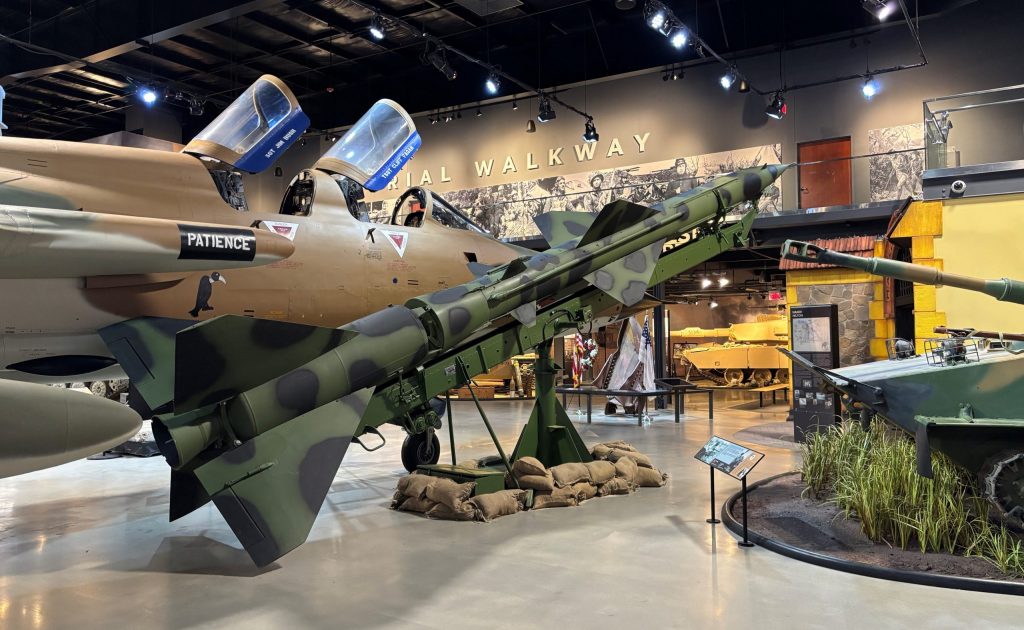
The American Heritage Museum proud to unveil the installation of a cosmetically restored S-75 Dvina—better known by its NATO designation, SA-2 “Guideline”— in authentic North Vietnamese markings in our Vietnam War gallery, positioned dramatically beside our F-105 Thunderchief configured for the legendary “Wild Weasel” mission. The SA-2 was a devastating anti-aircraft system during the Vietnam War and was responsible for over 206 American aircraft losses.
The restoration of the missile was accomplished by staff and volunteers of the American Heritage Museum restoration workshop over the past six months. The SA-2 missile is on long-term loan from the National Museum of the United States Air Force at Wright Patterson AFB in Dayton, OH.
Overview and Development
The S-75 Dvina—known to NATO as the SA-2 “Guideline”—is one of the most consequential surface-to-air missile (SAM) systems of the Cold War. Designed in the mid-1950s as a high-altitude air-defense weapon, it paired the two-stage V-750 missile with the SNR-75 Fan Song fire-control radar under a command-guidance scheme. First fielded in 1957, the S-75 proliferated widely and became the backbone of many nations’ air defenses for decades. It achieved early notoriety by downing a high-altitude RB-57 over China (1959) and CIA pilot Francis Gary Powers’ U-2 over the Soviet Union (May 1, 1960), and later a U-2 over Cuba during the 1962 missile crisis.
At the heart of the system is the SNR-75 Fan Song radar (E/F and G-band variants), which tracks a target and transmits steering commands to the missile; typical batteries were built around six single-rail launchers supporting a Fan Song guidance radar and associated acquisition radars.
Vietnam War Service and Effectiveness
North Vietnam began deploying the S-75 in 1965, quickly ring-fencing key targets such as Hanoi and Haiphong. The first successful engagement against U.S. aircraft occurred on July 24, 1965, when an F-4C was shot down—an event that catalyzed a rapid evolution in American tactics and electronic countermeasures. Over the course of the war, U.S. records attribute 206 fixed-wing aircraft losses to North Vietnamese SAMs (predominantly SA-2s). During Operation Linebacker II (Dec. 18–29, 1972), North Vietnamese defenses fired roughly 266 SA-2s; 15 B-52s were shot down according to U.S. accounting (with additional losses heavily damaged but recovered to crash outside North Vietnam).
As the SAM threat matured, U.S. forces developed “Wild Weasel” suppression of enemy air defenses (SEAD) tactics. The F-105F/G Thunderchief hunted Fan Song radars, using receivers to home on emissions and firing early anti-radiation missiles such as the AGM-45 Shrike and later the AGM-78 Standard ARM. These tactics, combined with improved jamming and maneuver (“SAM breaks”), steadily increased the number of SA-2s required per kill and reduced effectiveness over time.
Bottom line: the SA-2 significantly reshaped the air war over North Vietnam—forcing U.S. strike packages lower and into heavier AAA and changing mission planning—while the Wild Weasel enterprise and evolving countermeasures proved pivotal in blunting the missile’s impact.
Technical Description (V-750 missile / S-75 system)
-
Role: Command-guided, high-altitude SAM paired to SNR-75 Fan Song radar.
-
Missile designation: V-750 family (e.g., V-750V/VK variants).
-
Dimensions: Length: 34 ft 9 in); body diameter: 28 in
-
Launch weight: 5,100 lb
-
Warhead: 430 lb fragmentation high-explosive; proximity fuse.
-
Propulsion: Solid-fuel booster (≈5 sec) + storable liquid-fuel sustainer (≈20–22 sec).
-
Speed: Up to ~Mach 3.5
-
Effective engagement envelope: Range up to 28 mi; altitude up to 82,000 ft. Minimum altitude performance is limited; very low-level targets are challenging.
-
Guidance: Radio command guidance from SNR-75 Fan Song; batteries often cued by early-warning radars (e.g., Spoon Rest, Flat Face) with dedicated height-finders.
-
Battery layout: Typically six single-rail launchers around the radar/command post; North Vietnamese sites often adopted this star-shaped layout early in the war.



